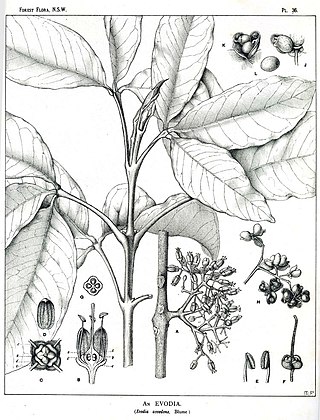Cotylelobium melanoxylon is a tree in the family Dipterocarpaceae. The specific epithet melanoxylon means "black wood", referring to the dark colour of the tree's wood. It was first described by Joseph Dalton Hooker in 1860 as Anisoptera melanoxylon and transferred to Cotylelobium by Jean Baptiste Louis Pierre in 1889. It is the provincial tree of Surat Thani Province, Thailand.
Glycosmis longisepala is a tree of Borneo in the family Rutaceae. The specific epithet longisepala is from the Latin meaning "long sepal".
Hopea depressinerva is a tree in the family Dipterocarpaceae, native to Borneo. The specific epithet depressinerva means "sunken nerve", referring to the leaf veins.
Vatica pedicellata is a tree in the family Dipterocarpaceae, native to Borneo. The specific epithet pedicellata refers to the prominent flower stalk or pedicel.
Vatica sarawakensis is a tree in the family Dipterocarpaceae. It is named for Sarawak, part of the species' range in Borneo.
Helicia petiolaris is a plant in the family Proteaceae. The specific epithet petiolaris means "stalked", referring to the leaves.
Madhuca costulata is a plant in the family Sapotaceae. The specific epithet costulata means "finely ribbed", referring to the leaves.
Diospyros coriacea is a tree in the family Ebenaceae. The specific epithet coriacea means "leathery", referring to the leaves. The species is native to Peninsular Malaysia, Singapore and Borneo.

Melicope accedens is a plant in the family Rutaceae.
Melicope glabra is a tree in the family Rutaceae. The specific epithet glabra is from the Latin meaning 'hairless'.

Melicope triphylla is a plant in the family Rutaceae. The specific epithet triphylla is from the Greek meaning 'three leaf', referring to the trifoliolate leaves.
Glycosmis macrantha is a tree in the family Rutaceae. The specific epithet macrantha is from the Greek meaning 'large flower'.
Buchanania insignis is a tree of Borneo in the cashew and sumac family Anacardiaceae. The specific epithet insignis is from the Latin meaning 'remarkable'.
Drimycarpus maximus is a tree of Borneo in the family Anacardiaceae. The specific epithet maximus means 'greatest', referring to the large leaves and fruits.

Castanopsis javanica, the Javan chestnut-oak, is a tree in the beech family Fagaceae. The specific epithet javanica is from the Latin, meaning "of Java".
Lithocarpus gracilis is a tree in the beech family Fagaceae. The specific epithet gracilis means 'slender', referring to the twigs.
Hopea obscurinerva is a tree in the family Dipterocarpaceae, native to Borneo. The specific epithet obscurinerva means 'indistinct nerve', referring to the veins on the underside of the leaf.
Shorea coriacea is a tree in the family Dipterocarpaceae, native to Borneo. The specific epithet coriacea means 'leathery' and refers to the leaves.
Shorea pinanga is a tree in the family Dipterocarpaceae, native to Borneo. The specific epithet pinanga is derived from a local name for the species.
Helicia symplocoides is a tree in the family Proteaceae, native to Borneo. The specific epithet symplocoides refers to the leaves' resemblance to those of the genus Symplocos.



